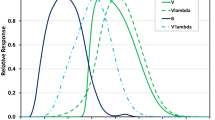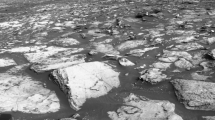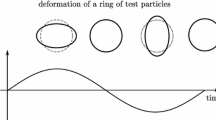Abstract
The optical navigation camera telescope (ONC-T) is a telescopic framing camera with seven colors onboard the Hayabusa2 spacecraft launched on December 3, 2014. The main objectives of this instrument are to optically navigate the spacecraft to asteroid Ryugu and to conduct multi-band mapping the asteroid. We conducted performance tests of the instrument before its installation on the spacecraft. We evaluated the dark current and bias level, obtained data on the dependency of the dark current on the temperature of the charge-coupled device (CCD). The bias level depends strongly on the temperature of the electronics package but only weakly on the CCD temperature. The dark-reference data, which is obtained simultaneously with observation data, can be used for estimation of the dark current and bias level. A long front hood is used for ONC-T to reduce the stray light at the expense of flatness in the peripheral area of the field of view (FOV). The central area in FOV has a flat sensitivity, and the limb darkening has been measured with an integrating sphere. The ONC-T has a wheel with seven bandpass filters and a panchromatic glass window. We measured the spectral sensitivity using an integrating sphere and obtained the sensitivity of all the pixels. We also measured the point-spread function using a star simulator. Measurement results indicate that the full width at half maximum is less than two pixels for all the bandpass filters and in the temperature range expected in the mission phase except for short periods of time during touchdowns.













Similar content being viewed by others
References
E.A. Cloutis, P. Hudon, T. Hiroi et al., Spectral reflectance properties of carbonaceous chondrites: 2. CM chondrites. Icarus 216, 309 (2011). doi:10.1016/j.icarus.2011.09.009
T. Hiroi, M.E. Zolensky, UV-Vis-NIR absorption features of heated phyllosilicates as remote-sensing clues of thermal histories of primitive asteroids. Antarct. Meteor. Res. 12, 108–116 (1999)
G.R. Hopkinson, Radiation-induced dark current increases in CCD, in RADiation Effects on Components and Systems (RADECS) (1993). doi:10.1109/RADECS.1993.316569
M. Ishiguro, R. Nakamura, D.J. Tholen et al., The Hayabusa spacecraft Asteroid Multi-band Imaging Camera (AMICA). Icarus 207, 714 (2010). doi:10.1016/j.icarus.2009.12.035
S. Kameda, H. Suzuki, Y. Cho et al., Detectability of hydrous minerals using ONC-T camera onboard the Hayabusa2 spacecraft. Adv. Space Res. 56, 1519–1524 (2015)
D. Lazzaro, M.A. Barucci, D. Perna, F.L. Jasmim, M. Yoshikawa, J.M.F. Carvano, Rotational spectra of (162173) 1999 JU3, the target of the Hayabusa2 mission. Astron. Astrophys. 549, L2 (2013)
N.A. Moskovitz, S. Abe, K.S. Pan, D.J. Osip, D. Pefkou, M.D. Melita, M. Elias, K. Kitazato, S.J. Bus, F.E. Demeo, R.O. Binzel, O.P.A. Abell, Rotational characterization of Hayabusa II target asteroid (162173) 1999 JU3. Icarus 224, 24 (2013)
T.G. Müller, J. Ďurech, S. Hasegawa et al., Thermo-physical properties of 162173 (1999 JU3), a potential flyby and rendezvous target for interplanetary missions. Astron. Astrophys. 525, A145 (2011). doi:10.1501/0004-6361/201015599
A.S. Rivkin, E.S. Howell, F. Vilas, L.A. Lebofsky, Hydrated minerals on asteroids: the astronomical record, in Asteroids III, ed. by W. Bottke, A. Cellino, P. Paolicchi, R.P. Binzel (University of Arizona Press, Tucson, 2004), pp. 235–253
S. Sugita, T. Morota, S. Kameda, R. Honda, C. Honda, Hayabusa-2 ONC Science Team, Science observations strategy for HAYABUSA-2 optical navigation cameras (ONC), in Lunar Planet. Sci. Conf., vol. XXXXIII, #3026 (2013), p. 2
S. Tachibana, M. Abe, M. Arakawa, M. Fujimoto, Y. Iijima, M. Ishiguro, K. Kitazato, N. Kobayashi, N. Namiki, T. Okada, R. Okazaki, H. Sawada, S. Sugita, Y. Takano, S. Tanaka, S. Watanabe, M. Yoshikawa, H. Kuninaka, The HAYABUSA2 Project TEAM, Hayabusa2: scientific importance of samples returned from C-type near-earth asteroid (162173) 1999 JU3. Geochem. J. 48, 571 (2014)
Y. Tsuda, M. Yoshikawa, M. Abe et al., System design of the Hayabusa 2—asteroid sample return mission to 1999 JU3. Acta Astronaut. 91, 356 (2013). doi:10.1016/j.actaastro.2013.06.028
F. Vilas, Spectral characteristics of Hayabusa 2 near-Earth asteroid targets 162173 1999 JU3 and 2001 QC34. Astron. J. 135, 1101 (2008). doi:10.1088/0004-6256/135/4/1101
F. Zellner, D.J. Tholen, E.F. Tedesco, The eight-color asteroid survey: results for 589 minor planets. Icarus 61, 1355 (1985)
Acknowledgements
The authors wish to thank Dr. S. Nakazawa, Dr. Y. Tsuda, Dr. K. Ogawa, and Hayabusa2 team for supporting our calibration test. The authors also wish to thank Dr. Y. Iijima for supporting our activities.
Author information
Authors and Affiliations
Corresponding author
Rights and permissions
About this article
Cite this article
Kameda, S., Suzuki, H., Takamatsu, T. et al. Preflight Calibration Test Results for Optical Navigation Camera Telescope (ONC-T) Onboard the Hayabusa2 Spacecraft. Space Sci Rev 208, 17–31 (2017). https://doi.org/10.1007/s11214-015-0227-y
Received:
Accepted:
Published:
Issue Date:
DOI: https://doi.org/10.1007/s11214-015-0227-y




